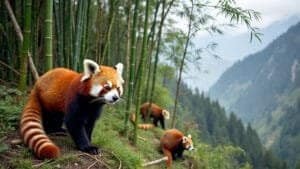Introduction
Red pandas and bamboo share a deep and critical relationship that shapes the ecosystems in which they live. As bamboo forms the primary component of the red panda’s diet, it directly influences their survival, reproduction, and population dynamics
Meanwhile, red pandas contribute to the health of bamboo forests through their foraging behavior and nutrient recycling
This article explores the interconnected roles of red pandas and bamboo, the threats to their relationship, and the broader implications for forest ecosystems and conservation efforts
The Importance of Bamboo to Red Panda Survival
Bamboo is a cornerstone of red panda survival, serving as their primary food source and shaping their behavioral patterns and habitat preferences. This reliance highlights the vital role of bamboo in sustaining red panda populations
Bamboo as a Primary Food Source for Red Pandas
Bamboo constitutes over 90% of the red panda’s diet, making it the single most critical resource for their sustenance. Red pandas primarily consume tender bamboo leaves and young shoots, which are rich in water content but low in calories
This dietary specialization requires red pandas to spend up to 13 hours daily foraging and eating to meet their energy needs
A study in Small Mammal Nutrition Studies (2019) found that red pandas consume approximately 1 to 2 pounds of bamboo per day, depending on availability and seasonal changes. This intensive feeding behavior underscores their dependence on the steady growth and accessibility of bamboo
Unlike other bamboo-eating animals like giant pandas, red pandas are more selective, favoring certain bamboo species that are native to their Himalayan habitats
This selective feeding behavior ensures they optimize nutrient intake while minimizing energy expenditure in searching for food
Specific Bamboo Species Preferred by Red Pandas
Red pandas show a preference for certain bamboo species, such as Arundinaria maling and Yushania microphylla, which are common in their native habitats. These species thrive in the cool, temperate forests of the Eastern Himalayas, typically at altitudes between 7,200 and 13,000 feet
The seasonal availability of bamboo affects red panda feeding habits. During spring and summer, red pandas primarily consume young bamboo shoots, which are more tender and nutritious
In autumn and winter, when shoots are scarce, they rely on bamboo leaves, which are tougher but still provide essential nutrients
How Bamboo Availability Affects Red Panda Populations
The availability of bamboo directly influences red panda population dynamics. In areas where bamboo is abundant, red pandas exhibit higher reproductive success and population stability
Conversely, in regions where bamboo forests are degraded or fragmented, red pandas face significant challenges, including malnutrition, reduced reproduction, and increased mortality
A 2020 study in Wildlife Conservation Science revealed that red panda populations in areas with severe bamboo depletion declined by up to 35% within a decade. The loss of bamboo forces red pandas to expand their home ranges in search of food, increasing their exposure to predators and human activity
Bamboo is not just a food source—it is the foundation of red panda ecology. Ensuring the health and availability of bamboo forests is essential for sustaining red panda populations and maintaining the balance of their ecosystems
How Red Pandas Influence Bamboo Forest Health
While bamboo is essential to red panda survival, these animals also play a role in maintaining the health and regeneration of bamboo forests. Through their foraging behavior and nutrient recycling, red pandas contribute to the ecological balance of their habitats
Red Panda Foraging Behavior and Bamboo Regeneration
Red pandas’ selective foraging helps regulate bamboo growth and supports the forest ecosystem. By consuming young shoots and leaves, red pandas prevent overgrowth in certain areas, which can promote healthier bamboo patches and open space for other plants to thrive
This natural pruning can encourage new bamboo shoots to sprout, ensuring a sustainable cycle of growth
A study in Forest Ecology and Wildlife (2020) highlighted that red pandas often target older bamboo plants for feeding, which may indirectly support the younger and more vigorous growth critical for forest renewal
This selective foraging contributes to the ecological diversity and health of bamboo forests
Nutrient Recycling Through Red Panda Droppings
Red panda droppings play an important role in nutrient cycling within bamboo ecosystems
Their waste contains partially digested bamboo, which returns nutrients to the soil and fosters the growth of new bamboo plants. This natural fertilization process helps sustain bamboo forests, particularly in nutrient-poor soils common in high-altitude regions
Additionally, red panda droppings may aid in seed dispersal for other plant species. While bamboo does not rely on seed dispersal in this manner, other vegetation in the ecosystem can benefit from the red panda’s movements and feeding habits
Balancing Bamboo Growth in Forest Ecosystems
The presence of red pandas helps maintain a balance in bamboo forest ecosystems. Without herbivores like red pandas, bamboo may grow unchecked, potentially leading to a monoculture that diminishes overall biodiversity
Red pandas contribute to a dynamic ecosystem where multiple plant and animal species coexist and thrive
Furthermore, red pandas’ interaction with bamboo indirectly supports other wildlife. By keeping bamboo growth in check, they ensure the availability of resources such as shelter and food for smaller mammals, birds, and insects that also depend on bamboo forests
The relationship between red pandas and bamboo is not one-sided; red pandas’ feeding and movement patterns play a subtle but crucial role in maintaining the health of their habitats
This mutual dependence underscores the importance of conserving both the species and their bamboo ecosystems
The Role of Bamboo in Forest Ecosystems
Bamboo is more than just a food source for red pandas; it is a keystone species in their habitats, supporting a wide range of biodiversity and maintaining the ecological integrity of temperate forests
Understanding bamboo’s broader role in these ecosystems highlights its importance for red pandas and other species that share their environment
Supporting Biodiversity in Bamboo Forests
Bamboo forests are home to a diverse array of plants and animals, many of which rely on bamboo either directly or indirectly
Birds, small mammals, and insects often find shelter and sustenance within bamboo groves, creating a complex web of interdependence. For example, birds may use bamboo for nesting, while insects feed on bamboo leaves and stems
A 2021 study in Forest Biodiversity Research revealed that bamboo forests support higher species diversity compared to adjacent non-bamboo habitats. This biodiversity is critical for maintaining the overall health and resilience of forest ecosystems
Red pandas, as a part of this ecosystem, play a dual role: they depend on bamboo for survival while also indirectly supporting other species by contributing to the health of the bamboo forests through their feeding and movement patterns
Bamboo as a Keystone Species in Red Panda Habitats
Bamboo functions as a keystone species in temperate forests, meaning its presence disproportionately affects the structure and functioning of the ecosystem
The growth of bamboo provides shade and stabilizes the soil, preventing erosion in steep, mountainous areas where red pandas live. Additionally, bamboo groves influence the microclimate of these forests, maintaining cooler and more humid conditions that benefit a variety of organisms
Without bamboo, the ecosystems in these regions would likely shift toward less diverse and less stable states. For red pandas, the loss of bamboo would mean not only the disappearance of their primary food source but also a drastic reduction in the suitability of their habitat
Interdependence Between Bamboo and Other Forest Species
Bamboo’s rapid growth and ability to regenerate after disturbances make it a critical resource for both flora and fauna
Its life cycle—marked by periodic flowering and subsequent die-offs—creates opportunities for ecological succession, allowing other plant species to emerge and thrive in the gaps left behind
This cyclical nature of bamboo also influences the behavior of animals in the ecosystem. For example, red pandas may shift their foraging areas based on bamboo availability, indirectly spreading nutrients and fostering ecological balance
Other herbivores, such as deer and small mammals, also benefit from bamboo’s availability as a food source during different stages of its growth
By supporting biodiversity and stabilizing ecosystems, bamboo plays a foundational role in the forests that red pandas call home. Its presence ensures not only the survival of individual species but also the overall health and resilience of the environment
Threats to the Red Panda-Bamboo Relationship
The intricate relationship between red pandas and bamboo is under significant strain due to a combination of human activities and environmental changes. Habitat loss, climate change, and unsustainable practices threaten both bamboo forests and the red pandas that depend on them
Climate Change and Bamboo Growth Patterns
Bamboo forests are particularly sensitive to climate change, with rising temperatures, shifting precipitation patterns, and extreme weather events disrupting their growth cycles
Bamboo requires specific conditions, such as cool temperatures and high humidity, to thrive. As these conditions become less predictable, bamboo forests are shrinking and moving to higher elevations
A 2020 study in Global Ecology Reports found that in some Himalayan regions, bamboo growth zones have shifted upward by approximately 300 feet over the past two decades
This compression of suitable habitat reduces the availability of bamboo for red pandas and concentrates their populations into smaller areas, increasing competition for resources
Additionally, the periodic flowering and die-off of bamboo—an event that occurs every 20 to 40 years depending on the species—can leave red pandas without a food source for extended periods. Climate change exacerbates this challenge by disrupting the timing and recovery of bamboo regeneration
Habitat Loss and Its Impact on Bamboo Forests
Deforestation and land conversion for agriculture, logging, and infrastructure development have led to widespread loss of bamboo forests
In Nepal and India, large portions of red panda habitats have been cleared, leaving fragmented patches of bamboo that are insufficient to support thriving populations
Habitat fragmentation not only reduces the availability of bamboo but also isolates red panda populations, making it harder for them to find food and mates
A 2021 report by Conservation Science Quarterly estimated that over 50% of red panda habitats in the Eastern Himalayas have been affected by human activities, significantly compromising the red panda-bamboo relationship
Human harvesting of bamboo for construction, fodder, and handicrafts further depletes the resource. In regions where bamboo is harvested unsustainably, the recovery of these forests is slow, leaving red pandas with limited options for foraging
Conservation Strategies to Protect Bamboo and Red Pandas
Efforts to conserve bamboo forests and protect red pandas are critical for preserving their interdependence. Reforestation initiatives aimed at planting native bamboo species in degraded areas help restore food sources and create continuous habitats for red pandas
Protected areas, such as national parks and wildlife reserves, play a crucial role in safeguarding bamboo forests. These zones provide undisturbed environments where bamboo can regenerate naturally and red pandas can thrive
For instance, the Singalila National Park in India and Langtang National Park in Nepal have been instrumental in preserving large tracts of bamboo forest
Community-based programs that promote sustainable bamboo harvesting are also essential. By involving local populations in conservation efforts and providing alternative livelihoods, these initiatives reduce pressure on bamboo forests while fostering a sense of stewardship
Addressing the Broader Impacts of Climate Change
Mitigating climate change is a long-term goal for preserving bamboo ecosystems. Reducing greenhouse gas emissions, promoting sustainable land-use practices, and protecting forest corridors are all critical steps
International cooperation among countries in the red panda’s range—such as Bhutan, India, Nepal, and China—is essential to address these challenges at a regional level
The threats to the red panda-bamboo relationship are complex and multifaceted, but proactive conservation efforts can help safeguard this vital connection. By addressing habitat loss, climate change, and unsustainable practices, we can ensure that both bamboo forests and red pandas continue to thrive
Conclusion
The relationship between red pandas and bamboo is vital to the health of their ecosystems. Bamboo serves as the primary food source for red pandas, shaping their survival, behavior, and population dynamics. In turn, red pandas contribute to the health and regeneration of bamboo forests through their foraging and nutrient recycling activities
This interdependence supports a diverse range of species and maintains the ecological balance of temperate forests in the Eastern Himalayas
However, this relationship faces significant threats from climate change, deforestation, and habitat fragmentation. As bamboo forests shrink and become more fragmented, red pandas struggle to find sufficient food and shelter, leading to population declines
Conservation efforts, including reforestation, protected areas, and community engagement, are critical to preserving both bamboo ecosystems and the red pandas that depend on them
By understanding and addressing the challenges facing this unique relationship, we can take meaningful steps to protect red pandas and the habitats they call home, ensuring the survival of this iconic species and the ecosystems they help sustain











